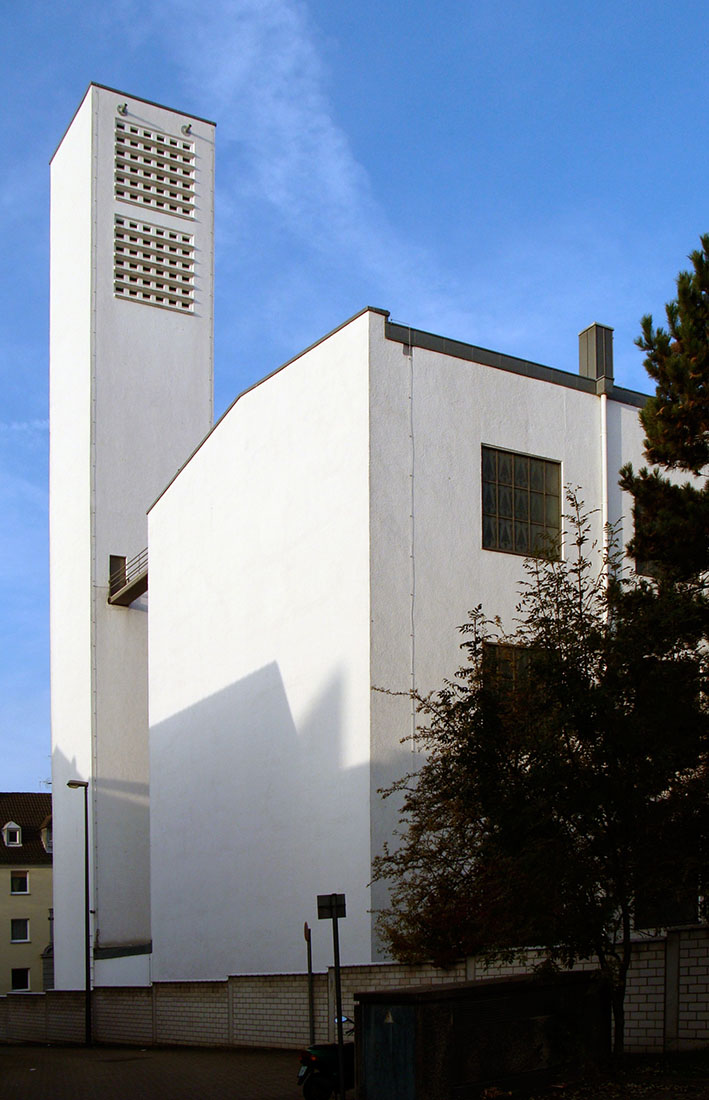 |
 |
 |
 |

Church of Corpus Cristy (Fronleichnam)
Düppel-, Leipziger Strasse, Aachen
1929 - 1930
Rudolf
Schwarz has been paid great attention for his design of the Corpus
Christi Church in Aachen. As a consequence of its radicalness the
building was extensively
discussed by architects and clergy. Due to its simple and memorable design, the Church continues to be the most famous building by Rudolf Schwarz.
In its time the unadorned interior sparked heated debates about the form of new churches.
The commission for a new parish church in the working class suburb Rothe Erde in Aachen was awarded to Rudolf Schwarz after his participation in the competition
for the Holy Ghost Church Aachen. According to the opinion of Rudolf Schwarz, the area for the new building was degenerated and neglected. He had the intention to set
the church as an ordering dominant within this disorder. There are known various preliminary designs for this Church. The church was realized with an elongated, high,
rectangular nave, which measures 47 x 13 m and has a height of 21 m. In the area of the top fourth of the walls are arranged large square windows. Two rows of these windows
prospect down to the floor in the area of the altar. The rear wall of the altar area has no windows. Lateral to the nave there is a 6 m wide, low aisle. In this aisle are located the
Confessional and Via Dolorosa Chapel. A mighty pillar of 4 m length, which is clad in black Belgian marble, separates the nave from the aisle. The whole interior is dominated
by the colors black and white. Walls and ceiling are completely white, while floor, altars, benches and confessionals are black. An important part of the equipment is the lighting,
which was designed as chains of lights hanging from the ceiling.
The 40 meter high tower has a square cross section and is situated in front of the aisle. A slender bridge connects the tower with the volume of the nave and emphasizes
the sober volums of the ensemble. During the early fifties the church was repaired after it had received several artillery hits in the war. Some years later, in the second half of
the seventies, there was a major renovation, which also saw changes in the interior of the church.
discussed by architects and clergy. Due to its simple and memorable design, the Church continues to be the most famous building by Rudolf Schwarz.
In its time the unadorned interior sparked heated debates about the form of new churches.
The commission for a new parish church in the working class suburb Rothe Erde in Aachen was awarded to Rudolf Schwarz after his participation in the competition
for the Holy Ghost Church Aachen. According to the opinion of Rudolf Schwarz, the area for the new building was degenerated and neglected. He had the intention to set
the church as an ordering dominant within this disorder. There are known various preliminary designs for this Church. The church was realized with an elongated, high,
rectangular nave, which measures 47 x 13 m and has a height of 21 m. In the area of the top fourth of the walls are arranged large square windows. Two rows of these windows
prospect down to the floor in the area of the altar. The rear wall of the altar area has no windows. Lateral to the nave there is a 6 m wide, low aisle. In this aisle are located the
Confessional and Via Dolorosa Chapel. A mighty pillar of 4 m length, which is clad in black Belgian marble, separates the nave from the aisle. The whole interior is dominated
by the colors black and white. Walls and ceiling are completely white, while floor, altars, benches and confessionals are black. An important part of the equipment is the lighting,
which was designed as chains of lights hanging from the ceiling.
The 40 meter high tower has a square cross section and is situated in front of the aisle. A slender bridge connects the tower with the volume of the nave and emphasizes
the sober volums of the ensemble. During the early fifties the church was repaired after it had received several artillery hits in the war. Some years later, in the second half of
the seventies, there was a major renovation, which also saw changes in the interior of the church.
